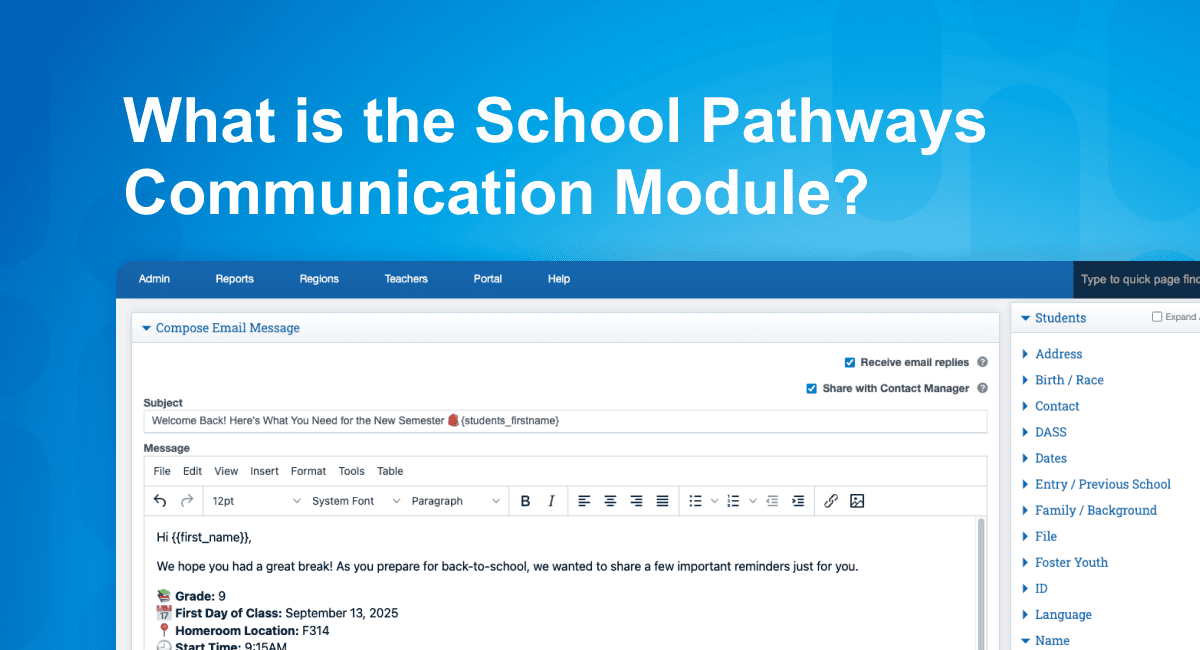Encouraging engagement produces incredible results in the lives of the students. According to the Online Learning Consortium, high student engagement not only boosts student satisfaction but also ignites a deeper drive to learn, combats feelings of isolation, and improves student performance in online learning. Still, while we know student engagement is vital, tracking it can feel elusive or burdensome.
The diverse nature of online interactions offers multiple ways for teachers to gauge the depth and quality of engagement. Yet, when it comes to individualized learning, numbers don’t tell the whole story. Educators need to tailor instruction to accommodate unique learning styles that aren’t based on quantitative data alone.
There are thoughtful and methodical best practices that can be implemented to effectively measure and fine-tune student engagement practices holistically at your school or in your district. In this article, we’ll explore how educators can leverage various key metrics to assess engagement from all angles and take virtual learning instruction to the next level.
Why Student Engagement Matters in Virtual Learning
The Challenges of Student Engagement in Virtual Learning
In an in-person classroom setting, it’s easy to scan faces and see who may be engaged and who isn’t. And compared to online learning, teachers can identify and intervene quicker when students become disengaged through non-verbal cues and direct interaction.
On the other hand, students participating in online or virtual classrooms can fly under the radar more easily due to the lack of a physical setting and less oversight from instructors. Consequently, they may encounter technological barriers, feelings of isolation, and a lack of support and resources, all of which can hinder their learning progress.
Transitioning into virtual instruction presents teachers with extra hurdles as well, including the adoption of new teaching methods and technologies, as well as the task of effectively teaching virtual learning students on a daily basis.
How Student Engagement Affects Positive Outcomes
Despite the potential obstacles, the outcomes for engaged students make it well worth finding solutions to ensure students are engaging in their virtual education.
A Gallup survey of over five million students reported that students who are more engaged are 2.5 times more likely to report receiving excellent grades and performing well in school. Additionally, they are 4.5 times more likely to be excited about the future compared to their disengaged peers. So if we know that engagement is the key to success in the classroom, as well as in students’ futures, how can teachers and administrators boost engagement effectively?
Key Virtual Engagement Strategies To Support K-12 Students
As online learning has become so prevalent in a post-pandemic world, educators have cultivated creative ways to motivate student participation.
In a recent blog post, we shared a number of effective tactics for boosting engagement with interactive learning. Some of these tactics include methods that foster student conversation, reflection, and collaboration, including using the “minute paper” to gauge student understanding at key checkpoints throughout a lesson or the Flipped Classroom Model for teachers to clarify concepts in a more targeted way.
Meeting social and emotional needs is another way to ensure engagement as well as a strong support structure for students in their time away from live class sessions. If students are learning completely independently, it’s important they still have regular check-ins with a teacher or counselor. Additionally, teachers should provide students with the opportunity to connect with their peers via clubs and extracurriculars to develop and sharpen their social skills, even if they’re also virtual.
When used properly, technology provides many of the best solutions to engage students. For example, gamification is a great way to quickly allow students to engage with the material and break up class time. Apps like Kahoot! provide learning games that can easily be integrated into the curriculum.
From various interactive tools and discussion formats to collaborative activities and dedicated check-ins, make sure to consider a range of strategies that meet students where they are — whether in real-time instruction or at their own pace. This approach not only keeps students engaged but also enhances learning outcomes and enriches their overall learning experience.
Signs of Student Disengagement
It’s no surprise that not all students will remain engaged consistently. But for students who are falling off track, it’s essential for educators to take a proactive approach. It’s also important to note that disengagement can manifest in various ways beyond students simply missing classes or failing to complete an assignment. Clear signs to spot increasing disengagement include:
- Decreased or halted interaction from students during class
- Late submission or non-submission of assignments by students
- Declining scores over time
- Students opting to keep their cameras turned off
Educators should routinely monitor student engagement levels during the school year so they can can intervene, sooner rather than later. That’s why paying attention to key indicators and metrics can help you recognize these trends early on, preventing chronic absenteeism and the need for more serious interventions.
How To Measure Student Engagement in Virtual Learning Environments
Now that we’ve covered what virtual student engagement looks like, let’s look at how educators can practically measure engagement in virtual learning environments.
While there are best practices, there is no one-size-fits-all approach for measuring engagement. To grasp a full understanding of the student experience, it’s wise to use both qualitative and quantitative methods.
Data Analytics
Most schools track a combination of metrics to measure presence and engagement including:
- Time on Task to measure the amount of time students spend actively engaged in learning activities like time spent in the LMS, and interacting with content.
- Participation Rates to track the frequency and consistency of student involvement in online discussions and class activities.
- Completion rates to track student progress and completion rates for assignments or projects.
While this data offers some insight into how students access and use teaching resources and activities, it becomes much more effective when leveraged together alongside data analytics tools. These tools can analyze patterns of student behavior, identify trends, and predict engagement levels. For example, a Personalized Learning System provides a centralized database of student engagement and activity data for teachers to see where students are actively progressing and which ones need more assistance and attention.
Assessments
Another way to evaluate student engagement is by using assessments. Teachers can use formative assessments to encourage students to reflect on their learning and set personal goals. For example, a teacher can ask them to rate their confidence levels through a chat feature or another digital platform. Students can also identify areas of strength and weakness in a particular subject in virtual breakout rooms during small group discussions.
Summative assessments, on the other hand, can help assess a student’s mastery of a subject, which can look like in-depth online discussions, peer-reviewed assignments, or even video essays. Using both types of feedback loops helps educators stay in touch with students’ learning progress every step of the way.
Surveys & Questionnaires
One of the most straightforward ways to gauge student engagement is to ask them directly. You can use surveys or questionnaires to gather feedback from students and families about their perceptions and experiences of your teaching. For example, you can ask them to rate their interest, motivation, and satisfaction on a number scale or provide open-ended prompts to understand where to improve instruction or allocate the necessary support for better student wellness and welfare. As good practice, surveys should be administered regularly throughout the school year for teachers to continue meeting the needs of students.
Observation
A more informal way to measure student engagement is to observe students in a variety of environments. Teachers can watch how students interact with peers, participate in group discussions, and engage during live instruction. Pay attention to subtle behavioral cues like eye tracking, reactions, and note-taking. These signs provide teachers with real-time feedback on students’ involvement during lessons, allowing teachers to adjust as needed. However, while some positive signs are promising, it’s important to avoid relying solely on potentially subjective interpretations. Using other assessment methods with observation ensures a more complete evaluation.
By monitoring a combination of these key metrics, educators can identify levels of engagement at a holistic view and understand what proper steps to take to intervene. A measured approach can enable schools to tackle student engagement with confidence—building toward the best lifelong academic outcomes.
Measure Engagement, Grow Lifelong Learners
No one wants to add to the burdens of teachers and administrators. However, neglecting best engagement practices in an increasingly virtual learning landscape will make it harder for educators to understand what’s working and what’s not. There are many tried and true tactics to increase engagement, and observing key metrics is the most effective way to identify students who need an intervention.
If you’re looking for a more innovative and integrated way to track these important metrics, School Pathways provides a Personalized Learning System that decreases documentation and compliance burdens that fall on teachers and administrators when tracking engagement. Working with your learning management system, the School Pathways’ PLS enables educators to build and monitor individualized learning plans, along with the activity reports needed to ensure successful student outcomes and maintain compliance with state regulations.
Contact us at School Pathways today to learn more about our Personalized Learning System and how it can make your teachers’ and administrators’ lives simpler and their teaching more effective.





